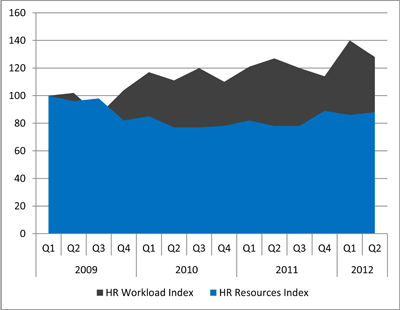HR’s Workload Increasing, Finds Index
By Ian Cook, CHRP
There is no doubt people are busy these days. However, the additional workload comes with its own risks and challenges. Organizations, like the people who bring them to life, cannot continue to do more with less and remain successful.
Historically, in lean times, HR has been a place to cut costs. However, many of the answers to organizational challenges are linked to HR practices or areas of expertise, such as managing multiple generations, sourcing the right type of talent and managing the overall employee mix between permanent, contract and casual so as to optimize productivity while staying competitive.
So, how does HR solve new, complex problems when its resources are constantly being reduced? In pursuit of this question, the HR Metrics Service devised a process to compare the workload demands on HR and the resources available to HR.
 Workload
Workload
The HR Workload Index captures and tracks variations in key items that drive the volume of work HR groups respond to. The index is generated from combining three rates:
Absence rate: Absence rates lead to additional work for the HR group for a range of reasons, such as supporting managers to manage their absentees and tracking overall levels of absence and the paths these absences follow (such as return to work, short- and long-term disability, suspension and termination).
The higher the absence rate, the more these types of outcomes will need to be tracked and managed, leading to an increased demand for HR resources.
Vacancy rate: Vacancies drive HR workload through the need to work through the process of how to fill a vacancy or source candidates. A high level of vacancies will drive a high workload for HR staff involved in recruiting.
Resignation rate: Resignations also increase the workload through the need to manage employees’ records, assist employees in exiting effectively and support managers to communicate these events with their staff.
The index is not intended to be a comprehensive list of all factors that drive HR workload but it does compile easy-to-access, widely reported and consistent factors that contribute significantly to the workload to which HR must respond.
Resources
The HR Resources Index is a combination of the factors that support HR to deliver on the workload demands. Effectively, there are two sources of resource for HR. The first is people, so the HR head count ratio is used to show whether HR groups have more or less staff to deal with the challenges they face. The second recognizes that sometimes HR may have fewer staff but it spends money on consultants and contract help. So, in addition to the HR head count ratio, the HR cost per employee balances out the index.
If an HR group lost staff and the head count ratio increased while the staff activity was replaced with a higher spend on contractors and consultants, then the HR Resources Index would remain neutral to reflect the shift in resources — as opposed to an absolute drop in resources that would come from a reduction in HR staff and HR costs per employee.
We have tracked these factors since 2009 and the data is captured quarterly to a clearly defined set of standards. The data is also audited to ensure the results can be trusted.
The data (see chart) shows HR is now handling a workload that is 30 to 40 points higher than at the start of 2009 and the resources available are 10 to 20 points lower over the same time frame.
At the peak in the first quarter of 2012, HR groups across Canada were dealing with a 60-point difference between demand and supply. Much of this difference came from an increase in both the resignation rate and absence rate at the start of the year.
It may be nice to be busy but this is not sustainable and not supporting organizations to remain competitive. HR is working significantly harder than in 2009 and the trend of an ever-increasing gap will not lead to success.
It does not look like the economy is going to make it easy to put more resources into HR so the answer is about doing less with less and developing a strong focus on what not to do so resources and demands can be balanced.
HR groups will be able to rely on this index going forward to provide the evidence for their need to be properly resourced to meet business challenges.
By the Numbers
HR is now handling a workload that is 40 points higher than in 2009, when the data was first tracked.


Ian Cook is director of research and learning at the British Columbia Human Resources Management Association (BC HRMA) and the HR Metrics Service in Vancouver. For more information, visit www.bchrma.org or www.hrmetricsservice.org.
Reprinted by permission of Canadian HR Reporter
© Copyright Thomson Reuters Canada Ltd. – October 2012 – Toronto, Ontario
800-387-5164 web: www.hrreporter.com








